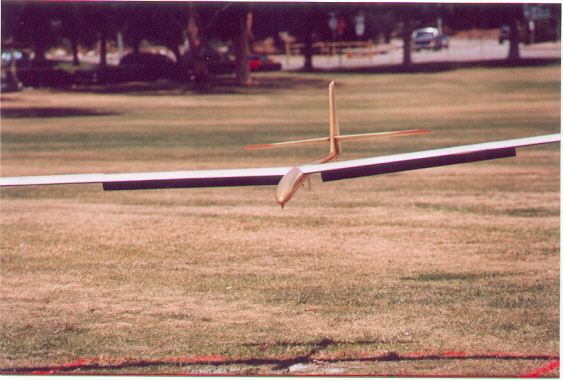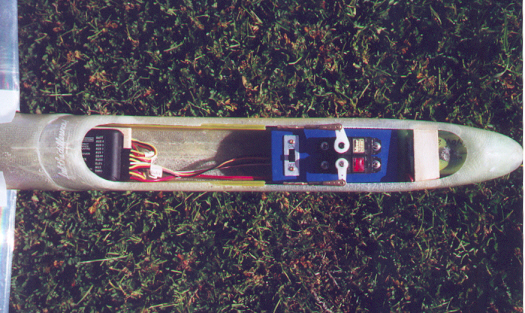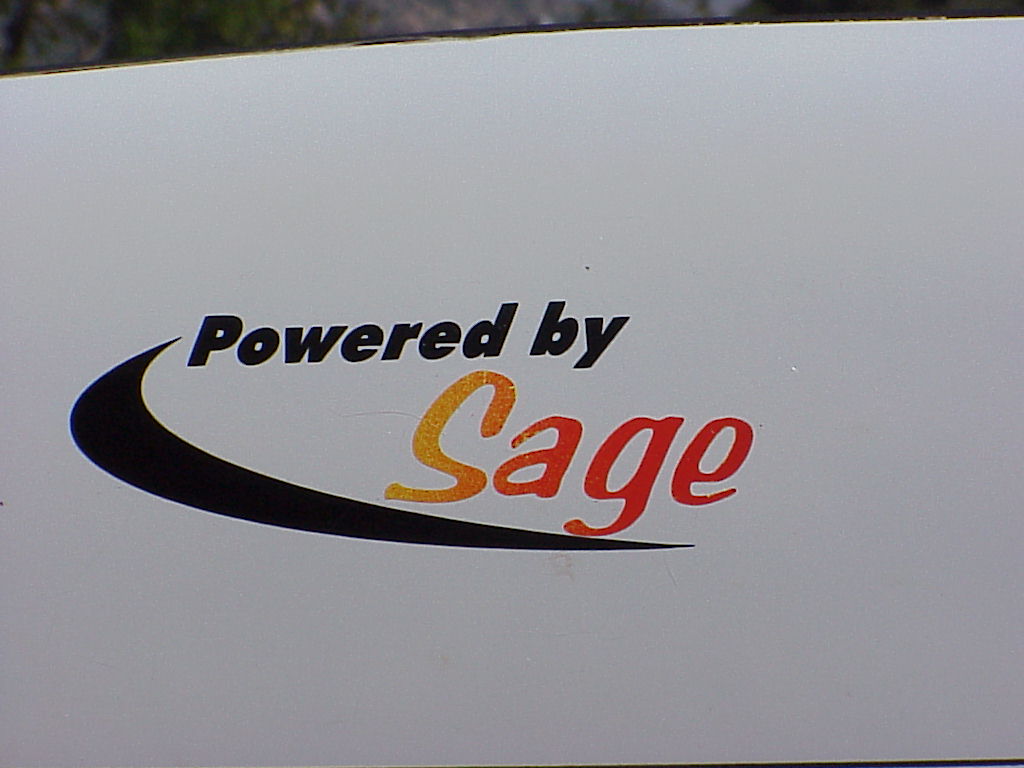 Looking for the spot...
Dan Borer's Addiction about to touch down at this years Rose Bowl Festival in Pasadena. Final results are at rcsoaring.com and as may be expected, both Addictions and sailplanes using Sage Products wings did extremely well.
Looking for the spot...
Dan Borer's Addiction about to touch down at this years Rose Bowl Festival in Pasadena. Final results are at rcsoaring.com and as may be expected, both Addictions and sailplanes using Sage Products wings did extremely well.
My Addiction.
My newest Addiction is 122" span, quad taper with an SD7037 airfoil. I'm using JR DS-368 digital servos on flaps and elevator, HS-85BB on rudder and ailerons. Finishing the wings was a matter of running the wires and making up the leads with connectors, this takes perhaps the longest of any particular task. Flaps and ailerons are tape hinged. The servo lead tunnels are pre-cut by Fred. I used 4-pin Deans connectors as they are readily available and work reliably. A four cell 1100mAh pack fits up front, I have my servos and switch mounted on a 1/8 inch ply tray behind that, and the Hitec Super Slim receiver is under the leading edge of the wing. Some weight can be saved by mounting the servos directly to the bottom of the fuselage but I chose to use a tray as it stiffens the fuselage considerably. The tow hook hole is predrilled, Fred supplies a beefy 3/16" hook and a tow hook block is now standard in the kit. |
|
General information.
Designed for open class thermal duration competition, the Addiction is a competitive sailplane that is more than capable of winning on any given day. It is difficult to give exact specifications because Fred custom makes each wing set and the span, taper and section are specified by the customer. That said, 120" is a common span and most use the SD7037 airfoil or a variant thereof. Spans between 115" and 125" are available.The kit itself is very complete, and critical elements such as the wing rod and stabilator mount holes are pre-drilled in a jig. This takes the guesswork out of alignment and goes a long way to ensuring a straight and good flying airplane. The wings, stabilator halves and rudder are all bagged, the tail surfaces have a natural finish and the wings are painted white on top with a natural black carbon lower surface. For a small additional fee, Fred can add color to the tips of the wings, his signature scheme is a three color fade (red/orange/yellow). I found all the bagging to be of superb quality and had basically nothing to do in the way of cleanup. Servo lead tunnels are cut in the wings and Fred will cut servo openings to match whatever servos you specify. Flaps and ailerons are pre-cut and just require hinging, the cuts are clean and the trailing edges are straight and sharp. All hardware is supplied, all that is required to finish the Addiction are items like hinge tape and plywood for the servo tray if you are going to use one. Carbon pushrods are supplied for the rudder and elevator, rods, clevises and horns are supplied for the flaps and ailerons, the towhook mounting block and rudder post are supplied also. The instructions supplied with the kit are sparse, but due to the level of prefinishing no more is needed. I actually did all the construction without needing to reference the instructions except for center of gravity position. The first open class glider I built was an Addiction which gives you an idea of how straightforward it is to put together.
New for 2001: As far as instructions, Fred has recently improved them and will now offer more information for less experienced or first time builders.
|
|
How does it fly?
I'm now flying what I consider to be my best Addiction yet. It uses the SD7037 airfoil
and I've gone up to 122" span, a little bigger than before and I like the change. The 7037 is different to the MH32 in that is has
less ranging capability but I have not found this to be a factor so far, I have had no trouble flying to the limit of my vision and
getting back, it just takes a little longer. The two areas I find it superior to the MH are hang time and landing, and this is where
it counts. It will stretch on landing and slow down more than the MH did and my landing scores are correspondingly higher.
Not that the MH32 can't be landed well, there's just a smaller margin for error and I don't see the need to make myself work
harder than I have to in that area. I have it pretty much dialed now and will be doing some more fine tuning and practice before
Visalia. It's first contest will be SC2 at Harbor on Sept. 23rd.
For more Addiction pictures see my Addiction
photo page or Don Richmond's Hilaunch site
What's new
Update 11/10/01- The Southern California Soaring Clubs 2001 contest
circuit is now complete, and Addictions dominated the end of year results. Indeed the placegetters in each of the Sportsman,
Expert and Master classes were flying Addictions. Full results can be found here.
Update 10/08/01- Edgar Vera is the 2001 Visalia Champ flying an Addiction. In case you're wondering, it's a 7037. Congratulations Edgar!
Update 07/10/01: The Addiction continues to dominate in this years Southern California
Soaring Clubs (SC2) circuit. With four contests complete, most of the top places for the coveted end of year award are held by Addiction pilots. Through the top ten finishers, Addiction pilots are in first, second, fourth, fifth, sixth, seventh, eighth, ninth, and tenth places. With some of best soaring pilots in the country flying the best equipment available, this level of domination is absolutely staggering and goes a long way toward proving how optimized the Addiction is for TD competition.
Update 04/01/01 -Addictions placed extremely well at the opening contest of the Southern California Soaring
Clubs (SC2) circuit hosted by the SULA club at Dominguez Hills. This is the most highly contested TD circuit in the
entire country, so when an single design dominates at this level, it's extremely unusual. The Addiction took five of the
top 10 places with finishes in first, second, fifth, sixth and seventh. The Addiction also won five of the nine trophies available.
Update 01/21/01- Recently Fred added a 9/16" joiner rod system as an option for the Addiction kit. Since the strength of a tube or rod
increase by the cube of its diameter, the 9/16" joiner rod is 42% stronger than the 1/2" rod that it replaces. In addition,
the 9/16" ID carbon fiber tube spar is also 42% stronger so the joiner rod can be made shorter while retaining a full
safety margin. Consequently the entire joiner rod system ends up weighing less than the 1/2" it replaces. A stiffer
joiner rod, a stronger wing and a lighter glider are the end result. Launches are approximately 20 feet higher as all
launch energy is stored in the wing instead of being partially dissipated by joiner rod flex. My new Addiction has
the 9/16" joiner rod system.
|
 Addiction fuselage
This is my typical Addiction radio installation. An 1100mAh NiCd up front, rudder and elevator servos on a one eighth inch plywood tray, and the receiver is velcroed to a balsa tray under the wing leading edge. The receiver position can differ from one model to another depending on your equipment installation, typically Addictions require little or no nose weight.
Addiction fuselage
This is my typical Addiction radio installation. An 1100mAh NiCd up front, rudder and elevator servos on a one eighth inch plywood tray, and the receiver is velcroed to a balsa tray under the wing leading edge. The receiver position can differ from one model to another depending on your equipment installation, typically Addictions require little or no nose weight. |




